|
|
ARTHROPODS:
Insects»
Spiders»
Centipedes»
Millipedes»
Sowbugs»
Harvestmen»
Mites
& Ticks»
Scorpions»
Identification
Tips»
About
the Critter Files»
Links» |
|
|
|
 |
GRASSHOPPERS
& KATYDIDS
Critter
Files/Insects/Grasshoppers &
Katydids
By Blake Newton
University of Kentucky Department of Entomology |
| |
|
| Common
Kentucky Grasshoppers & Katydids: |
| |
| TAXONOMY |
KINGDOM: Animalia
| PHYLUM: Arthropoda | CLASS: Insecta | ORDER: Orthoptera (grasshoppers
and crickets) |
| |
WHAT
IS A GRASSHOPPER?
LIFE CYCLE
ECOLOGY
PEST STATUS
COMMON KENTUCKY GRASSHOPPERS & KATYDIDS
COLLECTING & PHOTOGRAPHY
GRASSHOPPER FACTS
MYTHS, LEGENDS, AND FOLKLORE |
| |
| WHAT
IS A GRASSHOPPER? |
|
Like all insects, grasshoppers
have 6 legs, 2 antennae, and 3 body parts. Grasshoppers are
distinctive because of their large back legs. In fact, jumping legs
like these are only found on crickets, grasshoppers, and their relatives.
These insects also have leathery front wings (called "tegmina")
which help protect the delicate back wings. Females have a
long "ovipositor" at the tip of their abdomens which is
used to lay eggs.
WHAT IS A KATYDID?
Katydids are types of large grasshoppers in the family Tettigoniidae,
which includes all of the long-horned grasshoppers.
Grasshoppers are very closely related to crickets, and it can be
difficult to tell them apart. Although grasshoppers are often
bright green, and most crickets are brown, there are plenty of exceptions.
In fact, grasshoppers and crickets are so closely related
that some of the insects that we call "grasshoppers" are
actually more closely related to crickets than they are to other
grasshoppers.
The best way to identify grasshoppers is to become familiar with
the different families. There are three main families: Acrididae
(short-horned grasshoppers), Tettigoniidae (long-horned
grasshoppers and katydids), and Tetrigidae
(pygmy grasshoppers). See the common types
section below for more information about each of these groups.
|
|
| SIZE:
Body length of Kentucky grasshoppers from ½" - 2"
long |
| |
| LIFE
CYCLE |
|
Simple
metamorphosis: young grasshoppers hatch from eggs and resemble small,
wingless adults. Grasshoppers shed their skins as they grow,
usually molting several times before emerging as winged adults.
Most short-horned grasshoppers lay eggs in the soil, but some
species place eggs inside plant stems. Male grasshoppers "chirp"
to attract females. The familiar chirping sound is produced
with a "stridulating organ" located at the base of the
wings. Pictured below are typical nymphs of long-horned and
short-horned grasshoppers.
|
| |
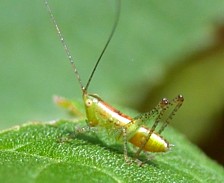 Long-horned
grasshopper nymph
Long-horned
grasshopper nymph
(B. Newton, 2003) |
 Short-horned
grasshopper nymph
Short-horned
grasshopper nymph
(B. Newton, 2003) |
| |
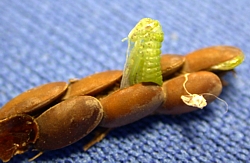 Katydid eggs
and hatchling (B. Newton, 2004)
Katydid eggs
and hatchling (B. Newton, 2004) |
| |
| ECOLOGY |
|
Most grasshoppers
are herbivores, and feed on many plant species, including crops
like corn, tobacco, and some vegetables. They are very common
in Kentucky, and are an important food source for many animals,
including spiders, centipedes, birds, reptiles, amphibians, and
small mammals. Most grasshoppers are active during the day,
and are common in sunny habitats that are covered with low-growing
vegetation. |
| |
| PEST
STATUS |
|
Although
grasshoppers can sometimes be serious pests of cultivated plants,
they are rarely a major concern in Kentucky. Read more about Pest
Grasshoppers in Kentucky.
|
| |
| |
| COMMON
KENTUCKY GRASSHOPPERS & KATYDIDS |
|
|
SHORT-HORNED
GRASSHOPPERS
FAMILY: Acrididae
Short-horned grasshoppers
are probably the most commonly encountered grasshoppers in Kentucky.
Short-horned grasshoppers are so-called because their antennae
are short compared to the antennae of long-horned grasshoppers:
the antennae of long-horned grasshoppers are usually longer than
the body, but the antennae of short-horned grasshoppers are rarely
more than half the length of the body. Shown
below are typical examples of short-horned grasshoppers.
|
| |
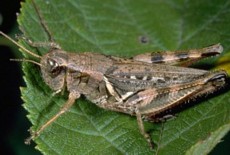 Short-Horned
Grasshopper (R. Bessin, 2002)
Short-Horned
Grasshopper (R. Bessin, 2002)
|
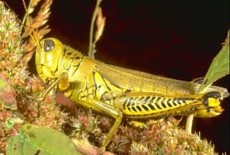 Short-Horned
Grasshopper (R. Bessin, 2002)
Short-Horned
Grasshopper (R. Bessin, 2002) |
|
|
|
LONG-HORNED
GRASSHOPPERS & KATYDIDS
FAMILY: Tettigoniidae
Long-Horned Grasshoppers
look very similar to short-horned grasshoppers, except that they
have longer antennae (usually longer than thier bodies). They
are not encountered as often as short-horned grasshoppers, but they
are still very common.
|
| |
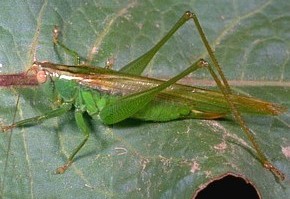 Long-Horned
Grasshopper (R. Bessin, 2002)
Long-Horned
Grasshopper (R. Bessin, 2002) |
| |
Katydids:
Although they are large and distinctive, Katydids are really
just a type of long-horned grasshopper. Katydids tend to be
very large compared to other grasshoppers, and are known for their
song: katy-did-katy-didn't, which is sung by both males and females
in some katydid species. |
| |
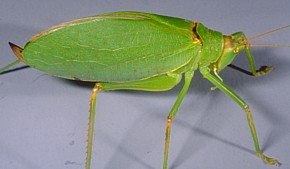 Katydid
(R. Bessin, 2002)
Katydid
(R. Bessin, 2002) |
|
|
|
PYGMY
GRASSHOPPERS
FAMILY:Tetrigidae
Pygmy grasshoppers look
like miniature short-horned grasshoppers. They are usually less
than 1/2" long, and are characterized by a long shield (part
of their pronotum) which extends all the way down the abdomen. |
| |
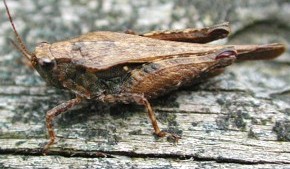 Pygmy
Grasshopper (B. Newton, 2002)
Pygmy
Grasshopper (B. Newton, 2002) |
|
| |
| COLLECTING
& PHOTOGRAPHY |
|
During summer months,
grasshoppers are easy to find and collect. Look for them during
the hottest parts of the day in gardens, crops, tall grass, and
weedy areas, where they can be seen jumping and flying away from
you as you walk past. They are quick to escape, so you may
need an insect net to catch one. Or, you could look for grasshoppers
on cool summer mornings, before they have "warmed up"
enough to move quickly. This is also a good time to snap a
photograph. |
| |
| GRASSHOPPER
FACTS |
|
Although grasshoppers
have large jumping legs, they also have wings, and most species
can fly very well. In fact, most grasshoppers just use their
legs as a "booster" to get them off of the ground; after
that, they can use their wings to fly.
|
| |
| MYTHS
- LEGENDS - FOLKLORE |
|
Sometimes when you
pick up a grasshopper, dark fluid will come out of the insect's
mouth. Because grasshoppers are sometimes found in tobacco,
it is sometimes said that this fluid is "tobacco juice",
and that the grasshopper is "spitting" at you because
it is mad. As it turns out, most grasshoppers can produce
this fluid, even if they haven't been eating tobacco. It is
not tobacco juice though: it is a defensive chemical produced inside
the grasshopper. |
| |
Original document: 25 May 2004
Last updated: 25 May 2004
Photos courtesy R. Bessin and B. Newton, University of Kentucky
The Kentucky Critter
Files are maintained by Blake Newton, Department of Entomology, University
of Kentucky.
Contact: blaken@uky.edu
|
|

